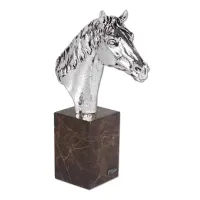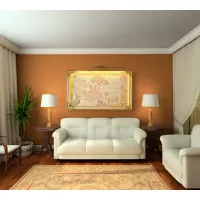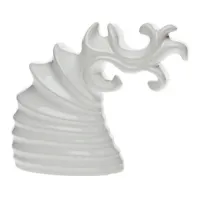Antique chestnut dining table from the 18th century
Luxury antiques
SKU: ANT-A1284
See other products from category Antiques and art or from manufacturer Antyki with shipping within 24 hours
Description
An antique dining table in chestnut color with two large drawers in the central part; The legs have a square cross-section and are spiral-shaped, giving the furniture a particular lightness. The rectangular tabletop consists of two boards that have separated in the middle. Their edge is shaped with a solid wood strip and is not visible anywhere. The tabletop has a specific charm associated with signs of use and minor defects that have developed over the years in the wood, giving it a unique allure. Made entirely of chestnut, it dates back to the late 18th century from the Po Valley in the pre-Alpine region of the Alps. The apron is framed and is 1 cm above the ground. 58.5, allowing for comfortable leg placement.
An antique dining table made of chestnut wood is a classic and rustic piece of furniture that brings a touch of warmth and tradition to the home. Chestnut is a strong and durable wood, known for its beauty and resistance to the test of time. An antique dining table made of chestnut wood can have an elegant and detailed design, with decorative inlays or carvings highlighting its craftsmanship.
This type of table is perfect for a dining room in a rustic or traditional style, adding a touch of authenticity and history to the surroundings. It can be paired with matching or modern chairs to create a personalized and unique look. Thanks to its quality and solidity, this antique chestnut dining table can also be used as a desk, as an office table with drawers, and can last for generations, becoming a valuable and cherished family heirloom over time.
Original antique furniture and accessories can be an excellent idea for decorating our interiors. Today, there are more and more enthusiasts of high-quality old products that have a specific character and soul. It's a nod to the history, creation, and design of classic and timeless furniture. There are many different styles in antique furniture, each with its distinctive features.
There are many different styles characterizing antique furniture, but we can highlight a few of the most important. Eclectic furniture belongs to the 19th century, which was dominated by the Biedermeier style. Its variations in the early years of this century include neo-Gothic, Gothic, Rococo, Louis Philippe style, and finally, the English Victorian style. By the end of the century, these styles transitioned into pseudo-styles of classicism, Renaissance, and Baroque.
Beautiful Empire-style furniture dates from the late 18th to the early 19th century. It originated during Napoleon's reign, where significant similarities and references to Roman and Greek decorations were imposed.
Classicist furniture is in the Louis XVI style, which also strongly references ancient architecture. Interesting and noteworthy are all antique products in the Rococo and Louis XV styles. Next is Baroque, whose name comes from the Portuguese 'barocco'—which translates to an irregularly developed pearl. These were very representative pieces of furniture, meant to literally drip with splendor and play a significant role in luxury. Exceptional, selectively used materials were employed to further emphasize the lofty tone of these products.
Today, we can observe how much influence the Baroque style had on today's classic furniture, which is designed with great similarity to the past era. Another significant style is the Renaissance, which flourished in the 15th and 16th centuries and also left a significant mark on the art of furniture making. Renaissance style was quite heavy and massive. Brown stains were used, as well as cornices, strong plinths, and bas-reliefs. It can certainly be said that these were quite specific products, but they offered many new possibilities, such as the construction of sideboards or generally broadly understood chest furniture. Here, too, there was an interest in mythology and ancient times, so supports or legs took on animal forms.
Lion paws, eagle heads – these are common features in Renaissance style. Currently, many global brands are recreating such furniture, taking inspiration from Italian and French creators. This is a sign of admiration and care for the history of the most beautiful Renaissance antiques. It is important to remember that each country had its own perception of furniture making, so each style in a given country had its own distinct character. This is very important, especially when searching for the right luxury antique for your interior.
The most important aspect of stylish antique furniture is originality. This is ultimately crucial from the buyer's perspective, as there are many counterfeits on the market. Luxury Products provides a document confirming the product's compliance with the actual description and photo. At your disposal, we have art appraisers, historians, and experts from around the world.
Attributes / Details
| SKU | ANT-A1284 |
| Manufacturer | Antyki |
| Model | A1284 |
| Material | chestnut wood |
| Size | Height: 79.5 cm Width: 188.5 cm Depth: 69.5 cm |
| Wiek | XVIII |
| Destiny | To dining room |
See catalog
Reviews
No reviews for this product.
















